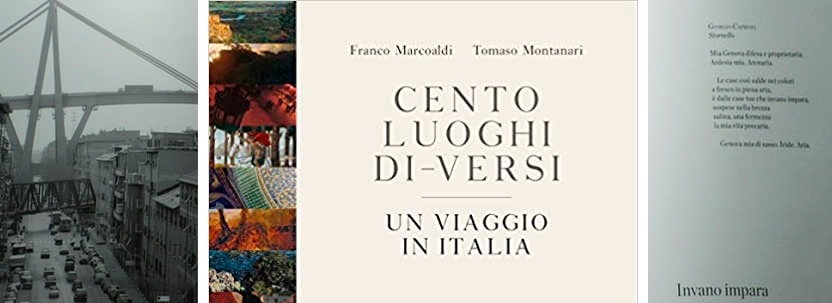Cento luoghi di-versi
A book to get lost and to find yourself in Italy between images and poems

A text written and published in Covid’s time that, although not a guide, transports the reader on a Grand Tour along our peninsula in the company of poets, photographers and artists.
“You know I found it a beautiful book, I was hooked from the very first page, so much so that I couldn’t help but read it all in one go.” Chi non vorrebbe avere per le mani un libro così?
An unexpected gift found under the tree or so.
An adventure, a novel, a novella, a character to identify with, a story to live or imagine, a story that gives an emotion. In short, one of those reads that from the start sticks in your hands and does not come off until you have reached the last page.
Cento luoghi di-versi by Franco Marcoaldi and Tomaso Montanari, Treccani 2020
is instead a book to be sipped, looked at and read calmly in order to reflect.
It should be enjoyed a little every day, because there is far too much to imagine and to get excited about to be reduced to reading it all in one go. It would be a waste, one would miss too many details, too many opportunities to exercise one’s memory and critical sense.
It is a very recent text, influenced by this year under house arrest, home-made, as the authors explain in the introduction.
In fact, it opens with a page on the epidemic that we all hope to leave behind us in the course of the year that has just begun, thanks to the vaccines that we constantly hear about in all the media.
It is a publication that talks about Italy, written by Italians, and a certain patriotism transpires here and there, but in doses appropriate to the subject matter. Each double page (photos and poetry) poses a theme to ponder on, and it does so simply with an evocative title, an image and a poem: the school going through complicated years, the Friuli earthquake of ’76, the Morandi bridge in Genoa, domestic confinement, loneliness, the charm of fragile Venice and many others.
The verses range from authors of poems and songs from various eras, with a predilection for the contemporary: Dante, Sciascia, Pasolini, De André, Boccaccio, Saba, Trilussa, Virgilio, Guccini, Ungaretti, Pico Della Mirandola, De Gregori, Montale, Michelangelo, Leopardi, Pino Daniele, to name but the best known.
But what is it about and why does it make sense to talk about it on Archweb?
Let us begin by saying that this is a beautiful tome with excellent value for money.
Reading it is neither by weight nor by the yardstick, but if someone wants to give it as a gift, they should know that it is a handsome, well-bound volume of about 24.5 x 28.5 cm, a good three pounds and 230 pages (half of them beautiful photographs). In short, it is not a cheap paperback, and for 20 euros you might even make a good impression by giving it to a friend.
Cento luoghi di-versi is an unordered (which is not to say untidy) collection of matching photo-poetry. You can open it at random, there is a picture on one side and verses on the other: you look at one, read the others, think about them a bit, maybe dream, remember or imagine, and then close. When one feels like it, one can repeat the game.
Strange book, no? Perhaps it is more a panacea for the intellect packaged in glossy sheets.
Fortunately, in the first few pages, the authors explain the meaning of their work in detail, but in my opinion you might as well not start there and leave the beginning to a later date and go a bit haphazardly from page 20 onwards.
Sometimes I have experienced something in front of a painting that I did not know, perhaps exhibited in a museum, or part of the decoration of a church, and it has always been a pleasant feeling. One could paraphrase Ulysses (Alberto Angela’s programme) and say the pleasure of discovery: an unexpected emotion that if I had known the painting would probably not have come, at least not like this.
Something similar can happen with this book: an image, a poem and if it fits, an emotion… on repeat, always available. Just keep it on your bedside table.
A hundred images for a hundred places and a hundred poems on the side, the count is soon done: that’s 200 glossy, pleasing pages. Yes, but what does this have to do with architecture?
There are piazzas, views, palaces, architecture and landscapes, photographed or painted and other works of art. Physical and non-physical places, of memory, of imagination, from the satellite, in any case all Italian or representing Italy, with the addition of verses that somehow offer an interpretation.
This should be sufficient.
These are Italian places, many distinct places with as many verses associated with them.
A place is not simply a site. A site may be part of a physical place, but it is enriched by a thousand other instances, from the stratifications of history, to the morphological relations with the context, to social dynamics and much more. The site is measured, the place needs intelligence, that inter-reading that makes us understand it (at least a little, as far as we can…) and gives us a completely different, much richer dimension.
The juxtaposition of a few verses (the authors are an art historian and a poet) can rightly be included in this type of investigation, of reading through, of a profound investigation of a place, of a journey through it in the wake of a literary suggestion.
If this justification is not enough, one can resort to the numerous goodies. An Alinari photo of the Ruccellai family’s emblematic sail on the edge of Leon Battista Alberti’s façade of Santa Maria Novella.
Is that better?
It was said that Tomaso Montanari’s opening text can be postponed, to enjoy the surprise of images and verses, but not left out, not skipped. I found some really useful lines in it about Article 9 of our Constitution: … ‘Italians are made’: we are a nation not because of blood, lineage, faith or ‘race’. But by way of culture.
And in fact the only one of the Charter’s fundamental principles that dares to utter the fatal word, ‘nation’, is precisely the one that links it to culture, research, landscape, and historical and artistic heritage.
Cento luoghi di-versi. Un viaggio in Italia.
Franco Marcoaldi, Tomaso Montanari
Treccani – Istituto della Enciclopedia Italiana, 19 novembre 2020
































































